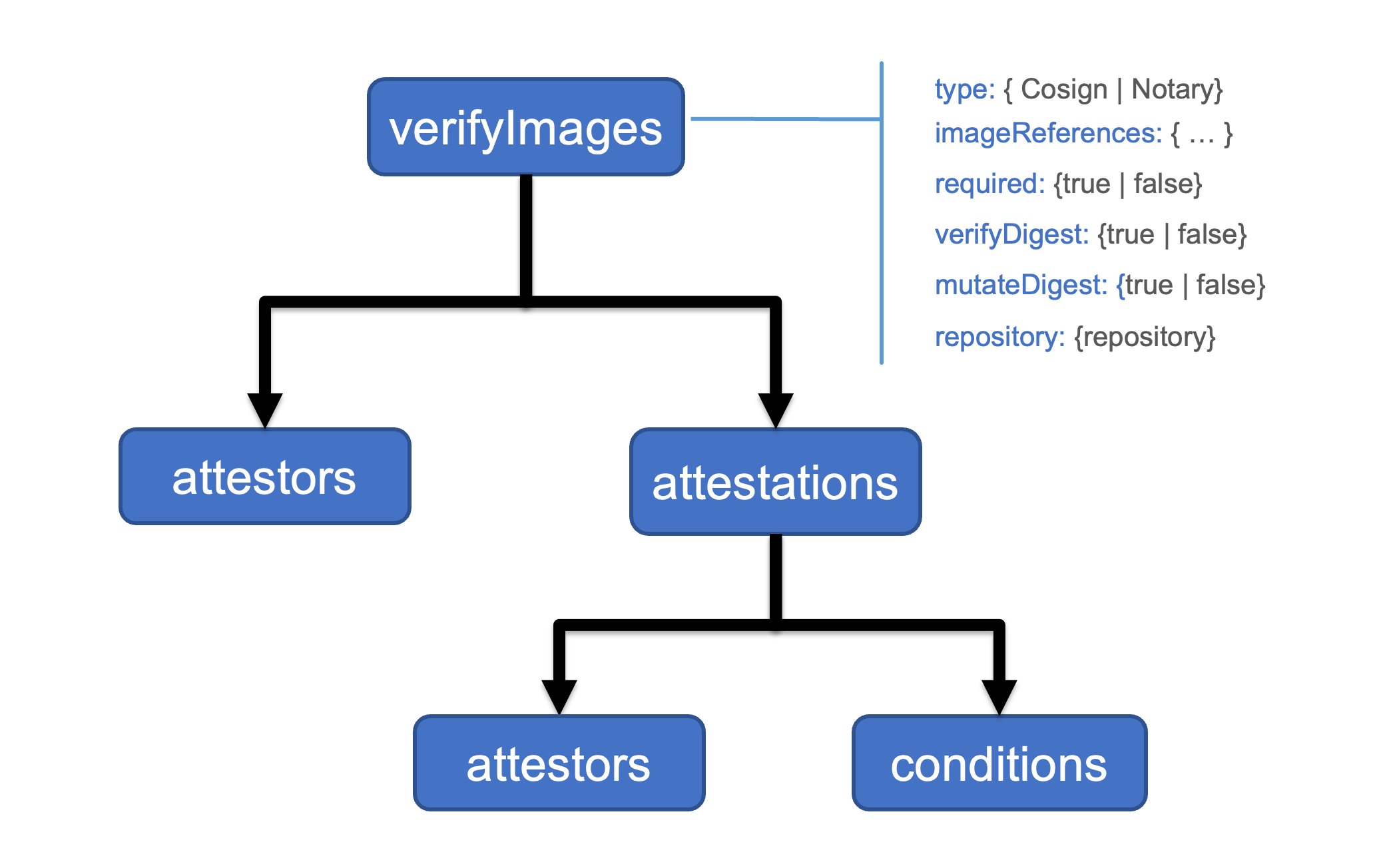Notary
Verify CNCF Notary format signatures using X.509 certificates.
The logical structure of an verifyImages rule is shown below:

Each rule contains the following common configuration attributes:
type: the signature type. Sigstore Cosign and Notary are supported.imageReferences: a list of image reference patterns to matchskipImageReferences: a list of image reference patterns that should be skipped.required: enforces that all matching images are verifiedmutateDigest: converts tags to digests for matching imagesverifyDigest: enforces that digests are used for matching imagesrepository: use a different repository for fetching signaturesimageRegistryCredentials: use specific registry credentials for this policy.A verifyImages rule can contain a list of attestors or authorities used to check the attached image signature. The type of attestor supported will vary based on the tool used to sign the image. For example, Sigstore Cosign supports public keys, certificates, and keyless attestors.
A verifyImages rule can contain a list of attestations i.e., signed metadata, to checked for the image. The nested attestations.attestors are used to verify the signature of the attestation. Any JSON data in an attestation can be verified using a set of attestations.conditions.
The rule mutates matching images to add the image digest, when mutateDigest is set to true (which is the default), if the digest is not already specified. Using an image digest has the benefit of making image references immutable and prevents spoofing attacks. Using a digest helps ensure that the version of the deployed image does not change and, for example, is the same version that was scanned and verified by a vulnerability scanning and detection tool.
The imageVerify rule first executes as part of the mutation webhook as the applying policy may insert the image digest. The imageVerify rules execute after other mutation rules are applied but before the validation webhook is invoked. This order allows other policy rules to first mutate the image reference if necessary, for example, to replace the registry address, before the image signature is verified.
The imageVerify rule is also executed as part of the validation webhook to apply the required and verifyDigest checks:
required is set to true (default) each image in the resource is checked to ensure that an immutable annotation that marks the image as verified is present.verifyDigest rule is set to true (default) each image is checked for a digest.The imageVerify rule can be combined with auto-gen so that policy rule checks are applied to Pod controllers.
The attestors declaration specifies one or more ways of checking image signatures or attestations. The attestors.count specifies the required count of attestors in the entries list that must be verified. By default, and when not specified, all attestors are verified.
The attestors.count specifies the required count of attestors in the entries list that must be verified. By default, and when not specified, all attestors are verified.
The imageRegistryCredentials attribute allows configuration of registry credentials per policy. Kyverno falls back to global credentials if this is empty.
The imageRegistryCredentials.helpers is an array of credential helpers that can be used for this policy. Allowed values are default,google,azure,amazon,github.
The imageRegistryCredentials.secrets specifies a list of secrets that are provided for credentials. Secrets must be in the Kyverno namespace.
For additional details please reference a section below for the solution used to sign the images and attestations:
Image verification requires multiple network calls and can be time consuming. Kyverno has a TTL based cache for image verification which caches successful outcomes of image verification. When cache is enabled, an image once verified by a policy will be considered to be verified until TTL duration expires or there is a change in policy.
In Kyverno’s admission controller deployment, users can configure the cache using the following flags:
imageVerifyCacheEnabled: Enable a TTL cache for verified images. Default is true.
imageVerifyCacheMaxSize: Maximum number of keys that can be stored in the TTL cache. Keys are a combination of policy elements along with the image reference. Default is 1000. 0 sets the value to default.
imageVerifyCacheTTLDuration: Maximum TTL value for a cache expressed as duration. Default is 60m. 0 sets the value to default.
The cache is enabled by default and significantly helps with execution time of verify image policies by making not accessing remote repository on every verification attempt. It should be noted that any change to the image/signature in the remote repository will not be reflected till the cache entry expires.
Verify CNCF Notary format signatures using X.509 certificates.
Verify Sigstore Cosign format signatures and attestations using keys, certificates, or keyless attestors.
Was this page helpful?
Glad to hear it! Please tell us how we can improve.
Sorry to hear that. Please tell us how we can improve.